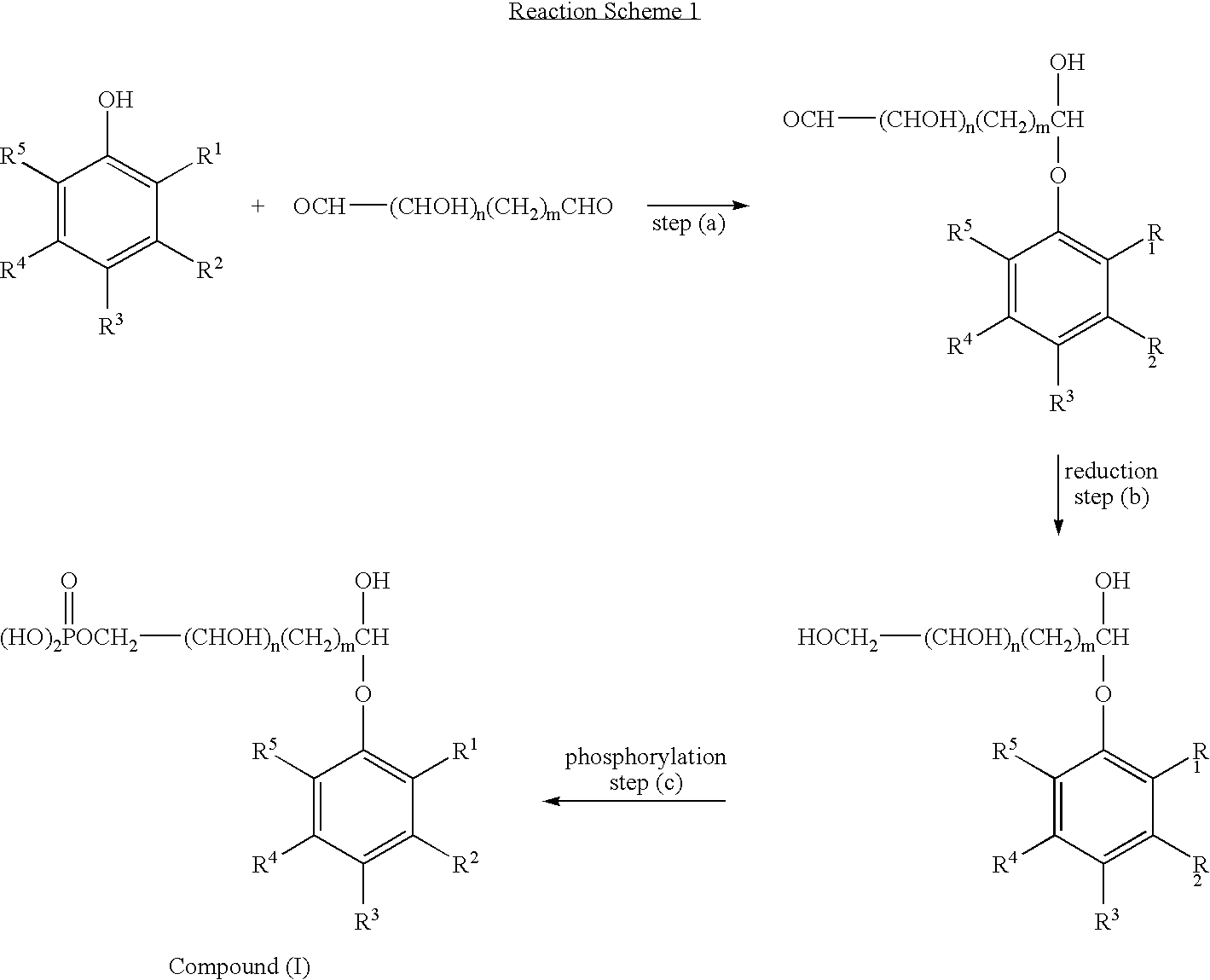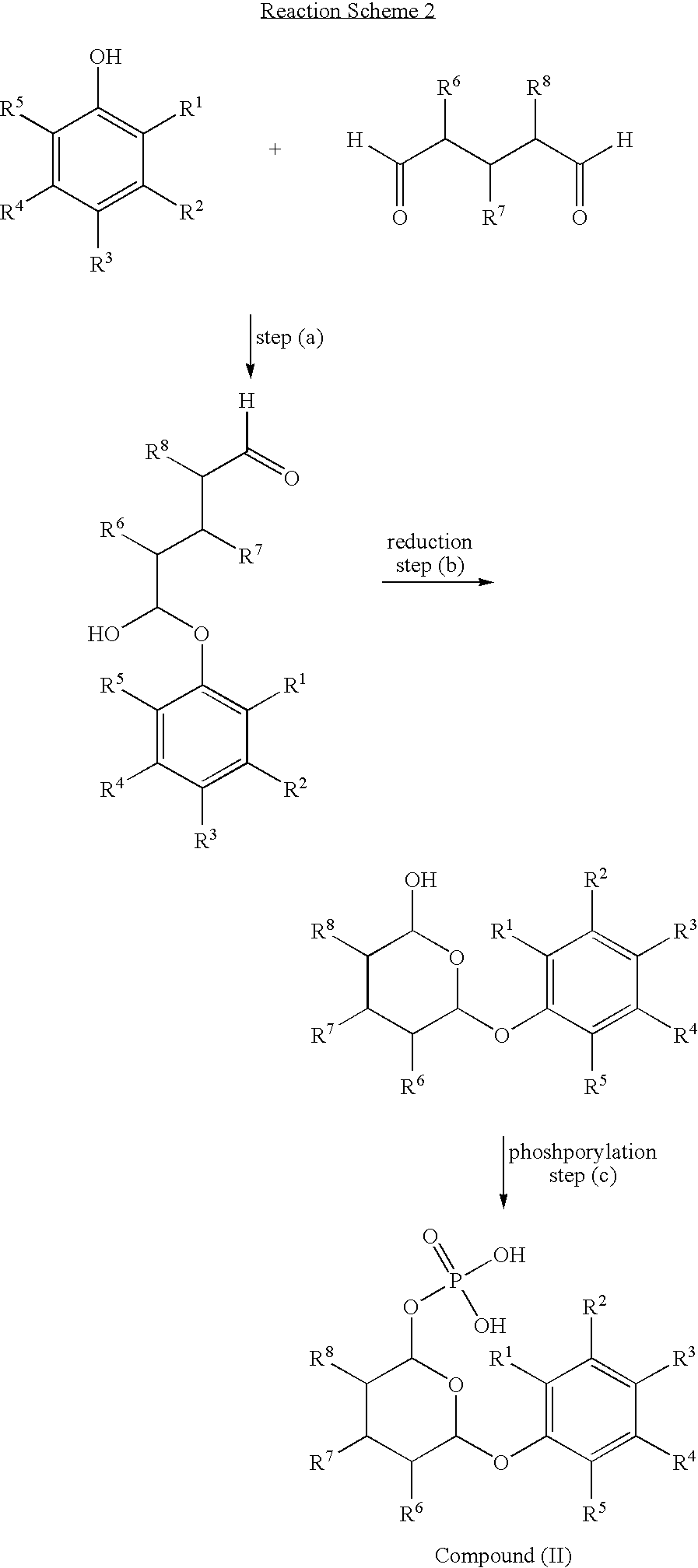Phosphate derivatives
a technology of phosphate and derivatives, applied in the field of phosphate derivatives, to achieve the effect of enhancing the delivery of certain active compounds
- Summary
- Abstract
- Description
- Claims
- Application Information
AI Technical Summary
Benefits of technology
Problems solved by technology
Method used
Image
Examples
example 1
Preparation of Phosphate Derivative of Propofol
[0045] 17.8 g (0.1M) of 2,6-diisopropylphenol (propofol) was placed in a 100 ml flask with a good agitator. 4.2 g of sodium hydrogen carbonate and 3.4 g of sodium carbonate were dissolved in 23.2 g of 50% aqueous gluteraldehyde. This solution was added to the 2,6-disopropylphenol with vigorous stirring over a one hour period. Then stirring continued for one hour. The water was evaporated to give the dry hemiacetal derivative of 2,6-diisopropylphenol (A). A was dissolved in 50 ml of toluene, then 7.8 g of P4O10 was added and the mixture stirred for one hour with the temperature maintained in the range 40 to 60° C. 50 ml of water was carefully added and the mixture stirred for thirty minutes to hydrolyse any pyrophosphates. The toluene phase was separated using a separating funnel and dried to produce 2-(2,6-diisopropylphenoxy)-tetrahydropyran-6-yl , dihydrogen phosphate (1).
example 2
Preparation of Phosphate Derivative of Propofol
[0046] 17.8 g (0.1M) of 2,6-diisopropylphenol (propofol) was placed in a 100 ml flask with a good agitator. 4.2 g of sodium hydrogen carbonate and 3.4 g of sodium carbonate were dissolved in 32.6 g of 50% aqueous trihydroxy pentandial. This solution was added to the 2,6-di-isopropylphenol with vigorous stirring over a one hour period. Then stirring continued for one hour. The water was evaporated to give the dry hemiacetal derivative of 2,6-diisopropylphenol (B). B was dissolved in 50 ml of toluene, then 7.8 g of P4O10 was added and the mixture stirred for one hour, maintaining the temperature in the range 40 to 60° C. 50 ml of water was carefully added and the mixture stirred for thirty minutes to hydrolyse any pyrophosphates. The toluene phase was separated using a separating funnel and dried to produce 2-(2,6-diisopropylphenoxy)-3,4,5-trihydroxy tetrahydropyran-6-yl, dihydrogen phosphate (II).
example 3
Preparation of Phosphate Derivative of Propofol
[0047] 17.8 g (0.1M) of 2,6-diisopropylphenol (propofol) was placed in a 100 ml flask with a good agitator. 4.2 g of sodium hydrogen carbonate and 3.4 g of sodium carbonate were dissolved in 12.8 g of 50% aqueous glyoxyal. This solution was added to the 2,6-diisopropylphenol with vigorous stirring over a one hour period. Then stirring continued for one hour. 3.8 g of sodium borohydride was added and the mixture stirred for one hour. The water was evaporated to give the dry hemiacetal derivative of 2,6-diisopropylphenol (C). C was dissolved in 50 ml of toluene, then 7.8 g of P4O10 was added and the mixture stirred for one hour, maintaining the temperature in the range 40 to 60° C. 25 ml of water was carefully added and the mixture stirred for thirty minutes to hydrolyse any pyrophosphates. The toluene phase was separated using a separating funnel and dried to produce 2-(2,6-diisopropylphenoxy)-2-hydroxy ethylphosphate (III).
PUM
| Property | Measurement | Unit |
|---|---|---|
| Structure | aaaaa | aaaaa |
| Amphoteric | aaaaa | aaaaa |
Abstract
Description
Claims
Application Information
 Login to View More
Login to View More - R&D
- Intellectual Property
- Life Sciences
- Materials
- Tech Scout
- Unparalleled Data Quality
- Higher Quality Content
- 60% Fewer Hallucinations
Browse by: Latest US Patents, China's latest patents, Technical Efficacy Thesaurus, Application Domain, Technology Topic, Popular Technical Reports.
© 2025 PatSnap. All rights reserved.Legal|Privacy policy|Modern Slavery Act Transparency Statement|Sitemap|About US| Contact US: help@patsnap.com


